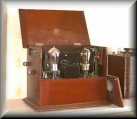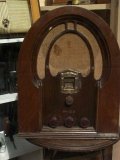Acoustic
| Acoustic means the way sound behaves in a particular environment. We talk about the acoustic of a particular space in the Lifeworld. |
| For example, an empty room with a high ceiling and hard reflective surfaces has a 'bright' or 'live' sound. A sitting room has a lot of absorbent materials (furniture, carpet, curtains). How do we notice this around us? See Darren Copeland's Ten Questions for a Listener |
| How do we translate these acoustics we know from the Lifeworld into the fictions of radio drama? |
| Many of the environments we live in do not have 'peaky' or exciting acoustics. (Example - domestic rooms do NOT.). |
| Other environments have exciting acoustics. (Examples - traffic in the street, sports, a factory, rain, wind). But these are too 'lively' (technical term). Selection is needed for the radio drama product. |
| The acoustic sound effect BACKGROUND that is put into many scenes is called 'atmos'. See Atmos bed (underneath the scene dialogue) |
| It is important to have a store of atmoses, to gather more. You need to record and create new atmoses. |
| You store these in SOUND BOX - production sound effects archive |
| The atmos is balanced against dialogue. Sometimes, the listeners will not particularly foreground the atmos in the radio play scene. But atmos is essential for the whole sound picture of the scene (the 'mise-en-scène'). |
 |
| The acoustic for a livingroom scene in a radio play is minimal, just a touch. But the livingroom is not a 'neutral' acoustic. Neither in the Lifeworld nor in the fictional, radio drama scene. You have to create just enough of an acoustic. The listeners do not experience the voices in a neutral acoustic. |
| Neutral would give the wrong signal as the dialogue does have a setting. Even unconsciously, we would be nudged by the illogicality. That is just enough to make us feel a bit uncomfortable, and a bit unwilling. We would not commit ourselves to the fiction and to the entertainment. |
| Many radio drama scenes used to be in a neutral acoustic in decades before FM and stereo. Listeners accepted the convention for the good reason that otherwise dialogue could not be easily heard against an atmos. |
| There were scenes, in the past technology of production, with an atmos, as storms, and at sea. But there is a long history of complaints against atmos and effects ('booming' and 'clanking'). Production was always live originally. The atmos was supplied by a gramophone recording. |
| Why did listeners accept this? See - Listening - how people listen |
OB - recording outside the studio
Microphone positions - five in total - from closest to 'moves off' (furthest)
Close-up - making some dialogue section more intimate

To Analysing radio drama
To Radio Drama Theory Lesson
Plan
|
|



